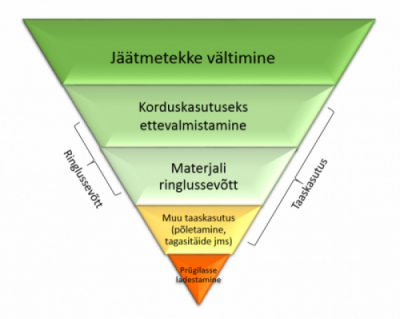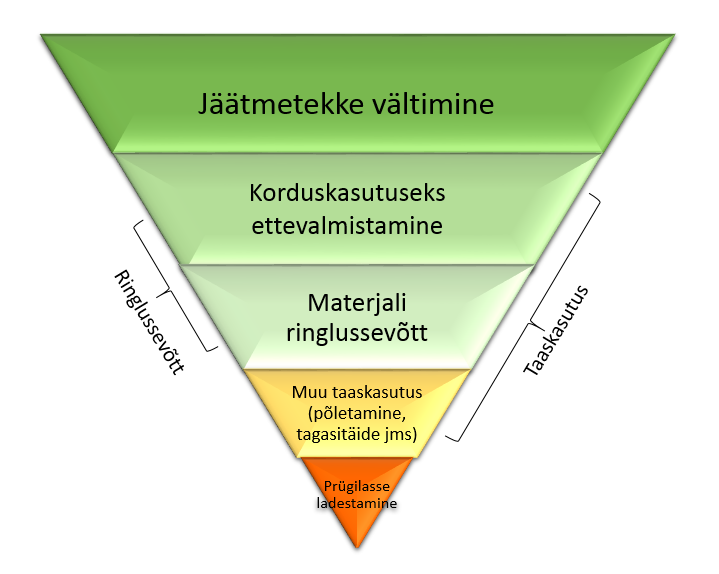Waste to Resources
Waste prevention, preparation of waste for reuse and recycling of waste are integral to the circular economy. Using waste as a resource helps to utilise the benefits of natural resources to the maximum and reduce the demand for new natural resources, hence, mitigating the environmental impact of adopting new natural resources as well as the generation of waste.
Waste prevention and development and application of waste management measures are based on a waste hierarchy:

Jäätmetekke vältimine – Waste prevention
Korduskasutuseks ettevalmistamine – Preparation for reuse
Materjali ringlussevõtt – Recycling of materials
Muu taaskasutus (põletamine, tagasitäide jms) – Other waste recovery (incineration, backfilling, etc.)
Prügilasse ladestamine – Disposal to landfills
Ringlussevõtt – Recycling
Taaskasutus – Recovery
WHAT is WHAT?
- Reuse
-
Reuse is implemented by products or product components that have not yet become waste. Reuse means that an object is reused for its original purpose. Therefore, reuse is a way to prevent the generation of waste.
For instance, if you use plates purchased from reuse stores or use your friend’s old phone, it is considered reuse.
- Preparation for reuse
-
Preparation for reuse entails processing waste. Products or product components that have become waste are inspected, cleaned or repaired in order for them to be reused without further pre-processing (such as demolishing or remelting).
For instance, if a broken chair that has been brought to the waste plant is repaired to be used as a chair again, it is considered preparation for reuse. It also includes the cleaning of glass bottles collected via the deposit system in order for them to be reused for their original purpose as bottles.
- Recycling
-
Recycling entails processing of waste. Waste is transformed into products, materials or substances in order to use these for their original or another purpose. Incineration, i.e. use of energy and processing of waste into materials that can be used as fuel or backfilling, is not considered recycling.
For instance, production of insulating materials out of old clothes, decking boards out of plastic packaging and composting of food waste are considered recycling.
Recycling is a narrower concept than reuse.
- Recovery
-
Recovery is a broader collective term for all operations carried out with waste, the primary result is the use of waste for useful purposes to replace other materials (e.g. natural resources that would otherwise be extracted) or preparation of waste to replace other materials in productions and in the economy in general.
Recovery includes preparation for reuse, recycling as well as other waste recovery (e.g. incineration by use of energy).
- Disposal
-
Disposal means disposal of waste to landfills, incineration without the use of energy or other activities that are not considered waste recovery. Disposal does not generate resources from waste, therefore the aim should be dispose of as little waste as possible.
What should I know about waste recovery?
Waste recovery requires a registration certificate of a waste management operator or a waste permit issued by the Environmental Board.
Information concerning the waste permit (in estonian)
Information concerning the waste management operator’s registration certificate (in estonian)
Jäätmetekke vältimise ja jäätmehooldusmeetmete väljatöötamisel ning rakendamisel juhindutakse jäätmehierarhiast:
